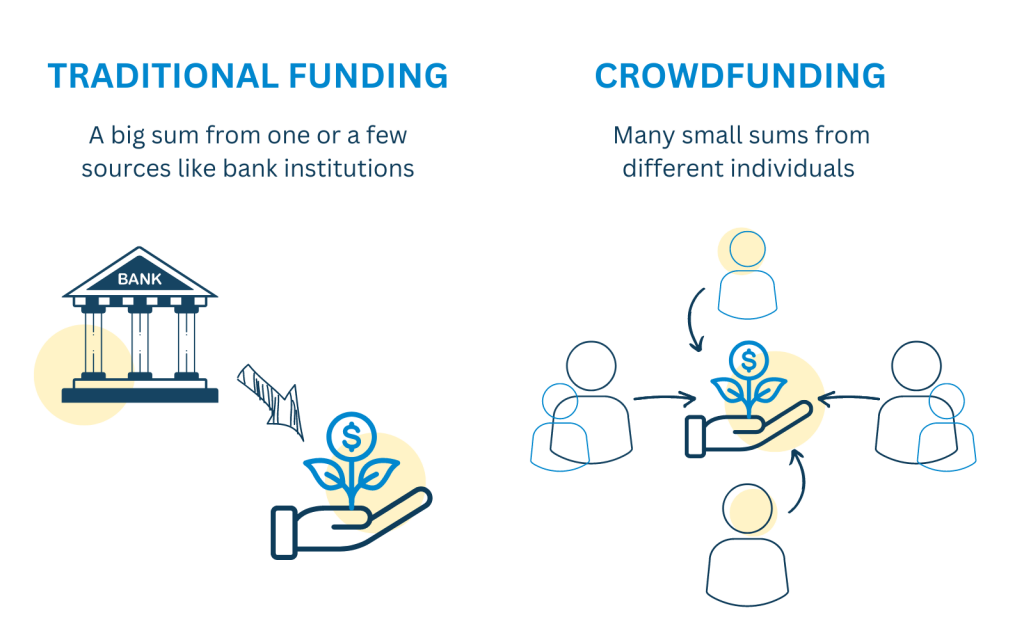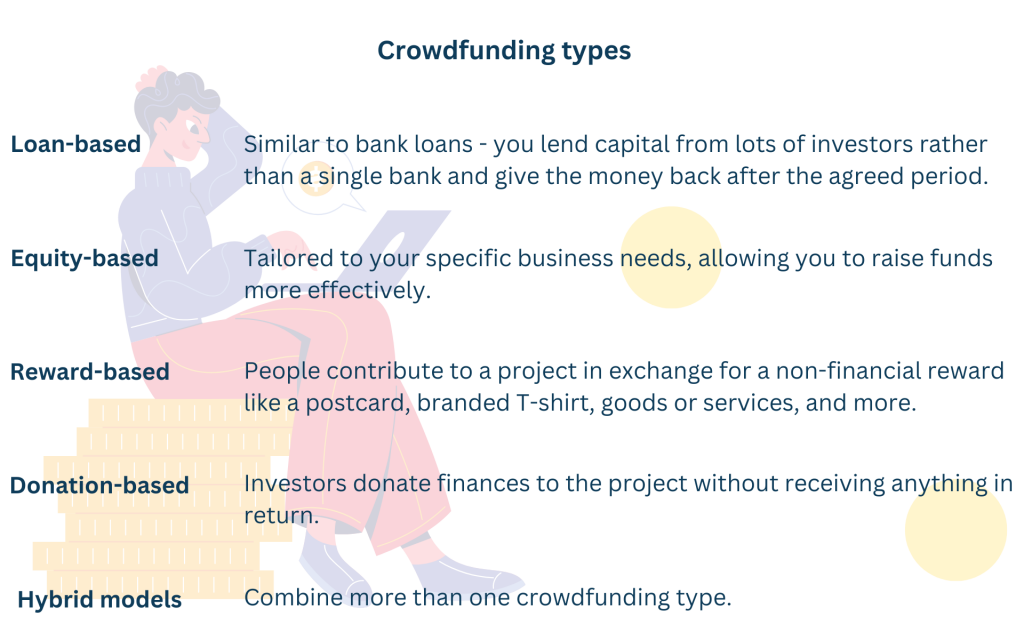Content
- What Is a Crowdfunding Platform?
- Types of Crowdfunding Platforms
- Functional and Non-functional Requirements for Crowdfunding Platforms
- Essential Features of Crowdfunding Platforms
- How to Decide on the Technology Stack
- Steps to Build a Crowdfunding Platform
- What Challenges You May Face When Building a Crowdfunding Platform
- On the Side Note
Every business starts with an idea. But a mere vision is not enough, even with the brightest and the most innovative concept. So, one needs to have solid capital to succeed.
One of the fastest ways to raise the required finances is to use a crowdfunding platform. While many businesses choose WordPress or other website constructors for building crowdfunding solutions or resort to using off-the-rack software, they do not always cover the full spectrum of needs. For instance, you may want to use biometric authentication or blockchain to ensure higher security and transparency. Or you may need to deploy API integration for smooth data exchange. That’s where custom crowdfunding apps come in handy.
Another scenario involving custom crowdfunding platforms is the desire to provide a user-oriented space for donors and fundraisers. That’s where sponsors find a project generating a desire to support it financially and where businesses ask for monetary assistance. As a platform holder, you can earn by having commissions from the raised funds or implementing other forms of monetization.
So, in this article
- We will delve into the process of custom crowdfunding platform creation.
- You will determine what types of crowdfunding solutions are and how they work.
- We will show you what features to look for in a crowdfunding application and how to decide on an appropriate technology stack.
What Is a Crowdfunding Platform?
Crowdfunding is a way of funding a project by collecting money from a large number of people. Fundraisers usually raise money online via a special platform. It is commonly used by startups as an alternative way of accessing funds. Crowdfunding is also a way of gathering a community around your project. You bring like-minded people together, let them contribute to a common cause, and spread the word about your business. So, a crowdfunding platform is a website or app that allows fundraisers, sponsors, and community members to communicate.
How Do Crowdfunding Platforms Work?
In order to fulfill business or personal goals, you refer to a large number of people rather than a centralized source to get the required financing through a special platform. That’s how crowdfunding works.
A dedicated platform serves as a hub where fundraisers and contributors meet. Usually, the crowdfunding process looks like this:
- Both parties register with the platform.
- The crowdfunding startup specifies project details, including its description with objectives and desired outcomes, deadlines, the target sum, and more.
- As the crowdfunding campaign starts, donors make their contributions via an integrated payment system directly through the platform.
- Once the deadline arrives, the collected amount is usually transferred to the fundraiser. If a third-party platform is used, a service fee will be charged.

Types of Crowdfunding Platforms
When it comes to defining the types of crowdfunding platforms, we may take various approaches to their differentiation. Based on what functionality and level of security you want to have in your crowdfunding solution, you may want to have an off-the-shelf or custom platform.

As there are different crowdfunding models, we can also distinguish between various platform variations.

Functional and Non-functional Requirements for Crowdfunding Platforms
As you embark to build a crowdfunding platform, you will want to be sure it meets all the requirements, both functional and non-functional.
First, just like any financial affair, crowdfunding is strictly regulated. So, never overlook the legal aspect when you create a crowdfunding platform. Verify that you have legal authorization to conduct investment transactions from the financial regulatory body. Make sure you comply with tokenization obligations, hold the proper level of certification, and more.
Note! The regulatory matters are different across countries. So having a lawyer in the target country may be a good idea for arranging crowdfunding without much hassle from your side.
When all the legal issues are covered, it’s time to think of functional requirements for the platform. A classic crowdfunding solution has two facets: for the fundraiser and the backer. You should think of a method for verifying financial solvency along with identity verification. The platform should also offer quick and secure web payment processing, effective account management, reports for tax authorities, and other modules depending on the needs.
Platform security should be one of your priorities as well. This refers to the authorization process, data storage, payments, and more.
Apart from this, the crowdfunding app should be simple to use both for investors and borrowers. Everyone should be able to easily get on board, navigate the menu, find the required information, and perform the desired actions from any device – computer, phone, or laptop.
Essential Features of Crowdfunding Platforms
As we already said, crowdfunding platforms cover two main roles – fundraisers and backers. So, the platform should meet the demand of both user groups.
Features for Fundraisers
The key objective of a fundraiser on the crowdfunding platform is to create and manage the campaign for raising funds. So, the basic functionality looks the following.
Profile
Before starting a campaign, the creator registers with the platform. To sign up, they should complete the registration via email, social media, or phone. After successful registration, the fundraiser fills out the required personal information, specifies payment details, provides legal documentation, and more.
Campaign Management
The crowdfunding platform should offer a simple way to add a new project and manage it (or multiple projects). So, creators need tools for starting a campaign and effectively running it. The functionality may differ, but the basic things are the following:
- Project creation – that’s where you specify the campaign topic, idea, duration, fundraising goal, and more.
- Project overview – here you should give a space for sharing the business plan, challenges, and other critical data.
- Rewards – that’s what contributors will get if they support the project (it may be optional depending on the crowdfunding model).
- Analytics – that’s a dashboard with the visualized progress of the campaign – how much money has been raised, from what funding sources, what rewards are popular, an average deposit payment, and more.
Payment Options
When thinking about payment processing, you’ve got to consider two aspects of this question:
- payment gateway and
- payment type.
When you create a custom crowdfunding platform from scratch, it is a good idea to go with a third-party solution. Building a payment gateway from scratch is expensive, time-consuming, and complicated, so you can take the shortcut by implementing a FinTech solution for your transaction processing. Luckily, the options are abundant, but you should look into the direction of services that have crowdfunding-specific functionality. It involves the ability to create online wallets, set repayment schedules, or return funds to investors if the campaign failed.
Note! As you pick between payment processing solutions, consider your region and the region of your target audience. Some of the service providers may be restricted or unavailable in your target market.
Additionally, decide on the optimal financing type – all-or-nothing or partial payment type. The difference between these models is the following:
- All-or-nothing – a creator receives the funds only when the objectives of the campaign have been fulfilled. Otherwise, the investors get their money back.
- Partial – a creator gets the funds they raised, even though the minimum financial goal hasn’t been met.
Additional Features
When you build a custom crowdfunding solution, you are not limited to a standard set of features.
- Social media – promote fundraising campaigns across social media profiles with a click of a button.
- Email marketing – send newsletters and personalized emails to increase awareness about your project.
- Integrations – sync other third-party or custom apps to achieve a higher level of efficiency.
Features For Investors
While fundraisers fight for a place under the sun, investors may have a hard time picking what campaign to invest in. Thus, the main goal of the crowdfunding platform is to help donors make decisions easier.
Profile
Again, everything starts with creating a profile. Users should be able to verify their identity via email, social media, or phone. One should not have a certain amount of capital for starting supporting crowdfunding campaigns – so, literally, any adult can register with a platform and discover a variety of projects.
Search
The search is the feature that will let donors quickly find the project according to their interests or capabilities. To quickly match the backer with the list of corresponding projects, the platform should have a filter with an option to set the category, timing, location, or other parameters.
Project Pages
Project pages should be optimized to give donors as much or as little information on the project they want to see. For the most part, the displayed project information is provided by the fundraiser, but there should be relevant basic fields that will give information about the campaign – its goals, mission, number of investors, rewards promised, business plan, and more.
Analytics
Contributors want to see how projects they invested in evolve, so the platform should have a dashboard that would enable tracking the campaigns’ progression.
Encouragement and Rewards
To make the crowdfunding experience more engaging for sponsors, platforms offer encouragement options in the form of rewards. This can be a sponsor badge, platform-specific coins, products, and more.
Payment Options
What payment processing services the platform offers are important for investors. Bringing together several most popular payment gateways will increase the odds to cover sponsors from different locations and with various payment preferences.
How to Decide on the Technology Stack
Before you start a crowdfunding platform development project, you will need to decide on the proper tech stack. But this may turn out to be easier said than done. If you pick the wrong toolkit, you will waste time, money, and won’t get the platform with the desired features. Thus, a strategic approach and a thorough product analysis are required for selecting the right crowdfunding technology.
Carefully consider your project purpose, business logic, and product requirements before you determine the technology stack.
- What do you expect the platform to do?
- What’s the scope of the project – do you want to build an MVP or a complex solution?
- How scalable would you like the platform to be?
These are a few things you’ve got to keep in mind while deciding on the appropriate technology.
One of the most deciding factors is the platform you are going to run the crowdfunding app on – mobile (iOS, Android, or both), desktop (Windows, macOS, Linux), web, or all at once.
Note! The more platforms you want to cover, the more complex the project will turn out to be. Thus, the more tools you will need to bring it to life. That is why many businesses start with an MVP implemented in one or a few environments. And then improve it over time.
For Mobile Development
Mobile solutions can be classified into native, hybrid, and cross-platform. Hence, their development is based on different programming languages.

For Web Development
To build a web crowdfunding platform, you may be willing to use:
- Ruby on Rails
- Python
- Java
- Angular
- PHP
- JavaScript
But here is a thing. Even the most extended framework can turn out to be useless in the hands of inexperienced developers. So, you should entrust the choice of the tech stack to the professional team.
Steps to Build a Crowdfunding Platform
Though a crowdfunding platform is a complex solution, the development process should not necessarily turn into a never-ending circle of tasks and duties for you. The best thing you can do to bring your fundraising idea to life is to cooperate with experienced developers who know the nitty-gritty of the development process. This will help you not only get the product of your dream but will also save tons of money and time.
Once you settle on a team, the development process is broken down into a few steps:
- Start the discovery stage
- Design and develop an MVP
- Launch the platform
- Maintain, update, and support the platform
Start the Discovery Stage
Every project starts with the discovery stage. For example, when we were working on the Groufi FinTech software for crowdfunding, we set up a series of online meetings with the product owner to outline product requirements. This is also an essential step for analyzing the market to figure out the unique selling proposition of the future product. This information is critical for deciding on the most suitable software type, product architecture, relevant tech stack, and required talents. By the end of this stage, there should be a vision of how to deliver a high-performing platform with the desired functionality.
Design and Develop an MVP
Considering the complexity of the crowdfunding platform, we always recommend building an MVP first. Because of basic functionality, you will bring the product to the market quickly, which has plenty of advantages. You will be able to get feedback from users, so you will know what features they want to see in the next platform iterations. You will start making revenue much faster. You will be adding new features one by one, knowing exactly what your users want – which will undoubtedly be leading to higher satisfaction.
So, MVP development starts with a prototype – a sort of sketch that showcases how the product’s pages will look like. As you agree on the designed wireframes, the developers set on writing the code and QA engineers on testing it to ensure the app meets all the requirements and has no bugs.
Launch the Platform
When the code is ready and QA engineers have no complaints about the platform’s performance and security, it’s time to launch the product. The app development company will set up everything for you, so you can cherish the moment and enjoy the birth of your crowdfunding platform.
Maintain, Update, and Support the Platform
In most cases, the product launch is only the beginning of the journey. The whole fun is awaiting you after its release. That’s when you start polishing the app according to the users’ needs and your business plan. You will be adding new features, improving the design, and extending the capabilities of the crowdfunding platform. All to ensure you stay on top of the competition, remain up-to-date with the latest trends, and deliver the experience that makes users stay with you.
What Challenges You May Face When Building a Crowdfunding Platform
Here are the things that pose difficulties for those aiming to create their custom crowdfunding solution:
- Security and privacy – to be able to transfer money safely and keep sensitive data neatly protected.
- Trust – to be convincing enough for donors (to persuade them to donate to a particular project on your platform) and fundraisers (to prove that you offer an effective platform for raising funds).
- Regulatory compliance – to build a solution that strictly follows all regulations and laws regarding crowdfunding.
- Interface – the platform navigation should be smooth both for backers and project creators, across different devices.
Reliable product development partners know how to take a stand against all potential issues. They will virtuously maneuver the code to deliver a secure, reputable, and user-friendly crowdfunding platform that complies with the regulations and makes gathering the funds much easier.
On the Side Note
Building a crowdfunding platform that will become a success is not that hard if you get the right people to work on it. Advantiss is here to share our profound expertise with you. Our developers, designers, and managers have years of hands-on experience so essential for creating a well-performing crowdfunding app within the desired timeframe and budget. To discover what opportunities you get when working with Advantiss, get in touch with us, and we’ll schedule a call to discuss your idea.




